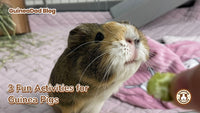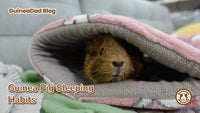If you’ve ever wondered what the difference is between American guinea pigs and American Satin guinea pigs, just know there is, in fact, a difference, and it’s not just their fur! They’re very similar in that their appearances are very close, but American Satin piggies carry a gene that gives their fur that satin, glossy effect. Physically, it may make their fur look pretty, but this trait comes with a load of health issues that affects their quality of life.
If you’re looking to own an American Satin guinea pig, you need to be aware of the special health issues that they have, and the special needs that they have to go along with them. They require a very attentive amount and level of care, and it’s important that you’re prepared to give them all the care they need in order to live as comfortably as they possibly can!
Origins
Some guinea pigs carry this satin gene, regardless of breed, and pass it down in their litters whenever they have babies. Breeding satin guinea pigs is discouraged as they will always pass down the gene and the health issues that come along with it, causing it to become a cycle.

Physical Characteristics of American Satin Guinea Pigs
American Satin guinea pigs have the same fur patterns as regular American guinea pigs, but they have the hollow hair follicle. This makes their hair glossy, especially when seen in sunlight. It also makes their fur look translucent. It is especially true when it comes to their little noses and feet.
Personality
Just like regular American guinea pigs, American Satin guinea pigs are clingy and outgoing, which means they’re more likely to let you give them a little cuddle!
Diet
In general, guinea pigs need a constant supply of hay and water, pellets, and around a cup of fruits and vegetables to supplement other nutrients they need, such as vitamin C, calcium, and others. Younger guinea pigs need more calcium than older ones, but older ones need more vitamin C. It’s important to make sure that your guinea pig has a balanced diet that doesn’t consist too much of any one thing.
Of course because of the satin syndrome, it makes it difficult for them to fully absorb calcium, no matter how much of it they consume. Sunlight exposure can help with this, since it helps with making vitamin D, which in turn helps absorb calcium. Syringe feeding can help when they have dental and jaw problems from bone decalcification, which is when their bones become thinner.
American Satin Guinea Pig Grooming
Grooming for American Satin guinea pigs isn’t too different from regular guinea pig grooming, because they have short fur and they’re unlikely to deal with their fur matting, or knots and tangles. In general, you only have to bathe guinea pigs fully if they’ve got urine and poop embedded in their fur!
Pedicures
Your American Satin guinea pig’s nails need to be trimmed at least once a month! However, this does depend on the individual guinea pig and their nail growth turnaround. For example, younger guinea pig’s nails grow faster than older guinea pigs.
Their diet also plays a role in how quickly their nails grow back. It’s also important to note that more active guinea pigs wear down their nails faster than less active ones.
With this line of thinking, it would make sense that sometimes older guinea pigs might need a trim more often if they’re not moving around as much as their younger counterparts. In the case of American Satin guinea pigs, many of them are not as active because the pain the may feel in their bodies, which means their nails may need trimming more often.
It’s important to note that guinea pigs usually have a low tolerance for nail clipping, this means you’ll need to be very patient with your piggy and only do a few at a time. Make sure to take some breaks in between, especially when your guinea pig gets fussy—just try again later! If possible, make nail clipping a two-person job.
One can hold the guinea pig so their legs aren’t dangling, and the other person can do the nail clipping. If only one person is available, then gently swaddle or burrito wrap your guinea pig in a blanket and hold them how you would hold a football! Then you can begin clipping their nails.
For a one person job, we recommend using the pouch that comes in the Offbeat Piggy Play Package. This is designed specifically for holding guinea pigs in the correct way to do things like administer medication, petting, and in this case, cut their nails!
Pedicure Tools
You can utilize nail clippers that are meant for small animals! Just be sure that you’re careful and don’t trim your guinea pig’s nails too short. This can cause bleeding, which can be stopped by applying styptic powder, or by gently pressing a paper towel to the affected area until it stops.
Dental Care
Note that guinea pig teeth are growing constantly, especially if their diet is rich in Vitamin C. However, their teeth are naturally worn down to normal lengths by the foods they eat. If they don’t eat enough hay or fruits and vegetables, their teeth won’t wear down properly, and this can lead to impaction, which can be painful for your piggies. When this happens, a visit to your vet becomes necessary for treatment.
Common health issues in American Satin Guinea Pigs
Aside from the normal health issues that most guinea pigs face, such as scurvy, urinary issues, respiratory infections, bumblefoot, etc., American Satin guinea pigs have their own set of ailments they suffer from because of the satin syndrome. Satin syndrome is the name of the health complications that come with carrying the satin gene. This puts the piggies at higher risk of developing kidney disease, which in turn affects their heart, bones and other areas of their organ systems. There are some visible signs of carrying the satin gene, including abnormal walking. This sometimes causes them to walk with a leg raised or laying down. They also tend to have some bone deformities because of the declining health of their bones.
American Satin guinea pigs often have difficulty eating, especially when it comes to chewing harder foods because of the decalcification that affects their teeth and jaw. Because of this, they will also go through some weight loss.
These piggies will also have an increased breath rate, which can also lead to lethargy since breathing takes so much effort for their bodies. They also will have a higher intake of water and fluids in general, which means their urination will increase as well.
There’s no cure for satin syndrome, but routine vet visits and vet care can help ease some of their suffering. Pain medication from your vet could help, and as mentioned before, sun exposure can do a lot of good for you guinea pigs when it comes to being able to increase their calcium absorption.
When it comes to putting less pressure on your guinea pigs bones and joints, our GuineaDad Liner and GuineaDad Premium Liner are the best for their fragile bodies. It’s soft and gentle on them, and can help ease some of the pain they suffer from moving around.
Cage Size
According to the Humane Society, guinea pigs need a minimum of 7.5 square feet of space, but in general, a guinea pig needs companionship to thrive, so it's best to have two guinea pigs. This would mean they need a minimum of 10.5 square feet. You want to give them as much space as possible so they can roam around freely and be active, therefore staying as healthy and youthful as they can.
The Offbeat Piggy Condo C&C cage is the best and safest guinea pig cage out there, and especially when paired with the GuineaDad Premium Liners, they make the perfect combo.
Where to find your own American Satin Guinea Pigs
It's most ethical to adopt your guinea pigs from a shelter if possible. It’s common for new guinea pig owners to give them up for adoption quickly after acquiring them when they’re not prepared for the amount of care their guinea pig needs—especially if they’re higher maintenance.
Some guinea pigs in the shelters have been mistreated and not properly cared for in the past, prior to their arrival at the shelter. Shelters do the best they can, but many have limited resources in helping hands and funds, and they take in and care for as many guinea pigs as they can. When we adopt from the shelter, guinea pig parents not only provide better customized care for each guinea pig, but also help free up rescue centers' capacity to help more animals in need.
If guinea pigs aren’t available at your local shelter, you can “rescue” them from a pet shop, since some pet shops may not be able to put as much of their time and resources towards specialized care for the guinea pigs, because they have so many other types of animals to look after as well.
What’s left to know?
Once you’ve done thorough research on American Satin guinea pigs, it’s important to realize that these piggies need a lot of specialized care that you’re going to need to be prepared to provide for them. These piggies go through quite a bit of suffering, and they need their parents to do their best in easing that!
One you’ve determined that you’re ready for this level of time and commitment, then you’re all good and ready to give an American Satin guinea pig all the love and support they need to live full and comfortable lives.








